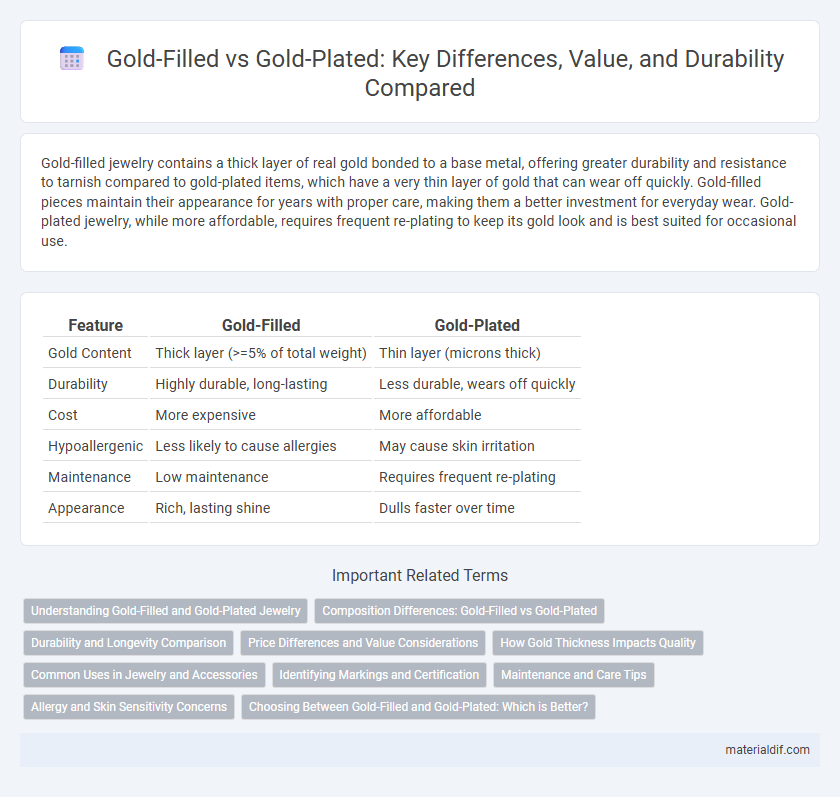Gold-filled jewelry contains a thick layer of real gold bonded to a base metal, offering greater durability and resistance to tarnish compared to gold-plated items, which have a very thin layer of gold that can wear off quickly. Gold-filled pieces maintain their appearance for years with proper care, making them a better investment for everyday wear. Gold-plated jewelry, while more affordable, requires frequent re-plating to keep its gold look and is best suited for occasional use.
Table of Comparison
| Feature | Gold-Filled | Gold-Plated |
|---|---|---|
| Gold Content | Thick layer (>=5% of total weight) | Thin layer (microns thick) |
| Durability | Highly durable, long-lasting | Less durable, wears off quickly |
| Cost | More expensive | More affordable |
| Hypoallergenic | Less likely to cause allergies | May cause skin irritation |
| Maintenance | Low maintenance | Requires frequent re-plating |
| Appearance | Rich, lasting shine | Dulls faster over time |
Understanding Gold-Filled and Gold-Plated Jewelry
Gold-filled jewelry consists of a thick layer of gold mechanically bonded to a base metal, making it more durable and resistant to tarnish compared to gold-plated pieces, which have a much thinner gold layer applied through electroplating. The gold content in gold-filled items is typically regulated to contain at least 5% gold by weight, offering greater longevity and value. Understanding these differences helps consumers choose between affordable, short-term gold-plated accessories and higher-quality, longer-lasting gold-filled jewelry.
Composition Differences: Gold-Filled vs Gold-Plated
Gold-filled jewelry consists of a thick layer of gold mechanically bonded to a base metal, typically comprising at least 5% gold by weight, ensuring durability and resistance to tarnish. In contrast, gold-plated items feature a much thinner layer of gold applied via electroplating over a base metal, often lasting only a few months before wearing off. The significant difference in gold content directly affects the longevity, appearance, and value of the two types of gold jewelry.
Durability and Longevity Comparison
Gold-filled jewelry contains a thick layer of gold mechanically bonded to a base metal, offering superior durability and resistance to tarnishing compared to gold-plated pieces, which have a much thinner gold layer applied by electroplating. The substantial gold content in gold-filled items ensures they maintain their appearance and value for many years, often lasting decades with proper care. Gold-plated jewelry tends to wear down quickly, exposing the base metal underneath and requiring more frequent re-plating to preserve its finish.
Price Differences and Value Considerations
Gold-filled jewelry contains a thick layer of gold bonded to a base metal, making it more durable and valuable with a higher price compared to gold-plated items, which have a thin layer of gold applied through electroplating. Gold-plated pieces are more affordable due to their lower gold content but tend to tarnish and wear off faster, reducing long-term value. When considering price differences, gold-filled offers better longevity and investment for the cost, while gold-plated suits budget-conscious buyers seeking temporary fashion accessories.
How Gold Thickness Impacts Quality
Gold-filled jewelry contains a thick layer of gold, typically 5% or more of the item's total weight, which provides superior durability, resistance to tarnish, and longer-lasting color compared to gold-plated pieces. Gold-plated items have a much thinner layer of gold, usually measured in microns, resulting in faster wear and fading over time. The thickness of the gold layer directly impacts the quality, longevity, and value of the jewelry, making gold-filled products a preferred choice for lasting appearance and hypoallergenic properties.
Common Uses in Jewelry and Accessories
Gold-filled jewelry contains a thick layer of gold mechanically bonded to a base metal, making it durable and ideal for daily wear in rings, bracelets, and necklaces. Gold-plated items feature a much thinner layer of gold applied through electroplating, commonly used for fashion accessories and costume jewelry due to lower cost. Both are popular in creating affordable yet attractive jewelry, but gold-filled pieces offer better longevity and resistance to tarnish.
Identifying Markings and Certification
Gold-filled jewelry typically features markings such as "14K GF" or "12K GF," indicating the karat and gold-filled layer, while gold-plated items often bear stamps like "GP" or "GEP" to denote gold electroplating. Certification from reputable organizations, including the Federal Trade Commission (FTC) guidelines and hallmarking bodies, ensures the authenticity and thickness standards of gold-filled pieces. Understanding these markings and certifications helps consumers discern genuine gold-filled items from less durable gold-plated alternatives.
Maintenance and Care Tips
Gold-filled jewelry requires less frequent maintenance than gold-plated pieces due to its thicker gold layer, which resists tarnish and wear. To preserve gold-filled items, gently clean with mild soap and warm water, avoiding harsh chemicals and abrasive materials. Gold-plated jewelry demands more careful handling, with regular polishing and minimizing exposure to moisture, perfumes, and lotions to prevent the thin gold layer from fading or peeling.
Allergy and Skin Sensitivity Concerns
Gold-filled jewelry contains a thick layer of gold bonded to a base metal, significantly reducing the risk of allergic reactions for individuals with sensitive skin compared to gold-plated items, which have a much thinner gold layer that can wear off quickly, exposing the underlying metal. Nickel and other common allergens in gold-plated jewelry often cause irritation, while gold-filled pieces generally avoid these issues due to their superior gold content and durability. Selecting gold-filled jewelry is preferable for those prone to metal allergies or dermatitis, ensuring prolonged skin comfort and minimizing sensitivity concerns.
Choosing Between Gold-Filled and Gold-Plated: Which is Better?
Gold-filled jewelry contains a thick layer of genuine gold mechanically bonded to a base metal, offering greater durability and resistance to tarnish compared to gold-plated items, which have a much thinner gold layer applied through electroplating. The durability of gold-filled pieces makes them a better investment for long-term wear, while gold-plated jewelry is more affordable and suitable for occasional use. Choosing between the two depends on budget, intended usage, and desired longevity of the jewelry.
Gold-Filled vs Gold-Plated Infographic

 materialdif.com
materialdif.com